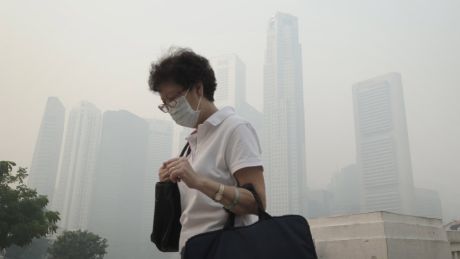Singapore — resource-poor and dependent on services, exports, and tourists — is reeling from the effects of smog reportedly coming mainly from waste being burned in Indonesia’s palm plantations. For days, a haze has blanketed the prosperous city-state and the “smell of burning wood” has seeped into buildings making residents’ efforts to avoid its effects by staying indoors all but futile.

The effects on the economy, however, is what is infuriating many Singaporeans the most…
| SUPPORT INDEPENDENT SOCIAL COMMENTARY! Subscribe to our Substack community GRP Insider to receive by email our in-depth free weekly newsletter. Opt into a paid subscription and you'll get premium insider briefs and insights from us. Subscribe to our Substack newsletter, GRP Insider! Learn more |
With the country’s exporters hurt by weak demand worldwide, Singapore had been relying on the tourist and service sectors to help maintain growth, which ING had expected to be 2.2 percent this year. Now, though, “you can just forget about tourism inflows in the rest of the year,” said Condon. He expects the smog to cut about half a percentage point from Singapore’s growth rate.
Last Friday, Singapore’s Smog Index “has hit the critical 400 level, making it potentially life-threatening to the ill and elderly people, according to a government monitoring site.” This is almost double the previous air pollution record of 226 hit in 1997 which was also caused mainly by slash and burn techniques adopted by farmers in Indonesia.
In all countries affected by the smoke haze back then, an increase of acute health outcomes was observed. Health effects; included emergency room visits due to respiratory symptoms such as asthma, upper respiratory infection, decreased lung function as well as eye and skin irritation, were caused mainly by this particulate matter. In Singapore, for instance, health surveillance showed a 30% increase in hospital attendance due to air quality related symptoms. Generally, children and the elderly, as well as those with pre-existing respiratory and cardiac diseases were the most susceptible to adverse health outcomes from the haze exposure. The smoke haze episode has added to the urban and industrial air pollution in Southeast Asia, causing it to reach alarming levels in many metropolitan areas.
The country’s worst environment-related disaster in more than ten years “could last weeks” according Singapore Prime Minister Lee Hsien Loong. ABC News reports that “Indonesian and Singaporean officials have been holding emergency talks on how to extinguish the fires on farms and plantations on Sumatra island, which are also affecting Malaysia.”
At a late-night emergency meeting,, president Susilo Bambang Yudhoyono ordered disaster officials to “immediately mobilise all the country’s resources” to extinguish the fires on Sumatra island that created vast palls of smoke.
Indonesia’s national disaster agency said that two helicopters with cloud-seeding equipment were sent early Friday from Jakarta and Borneo island to Riau province, where hundreds of hectares of carbon-rich peatland are ablaze.
“Hopefully, we will be able to create artificial rain today,” agency spokesman Sutopo Purwo Nugroho said.
It may take a lot more to impress Singaporeans whose affluence affords them a louder voice and a bigger soapbox when it comes to expressing indignation on the Third World lifestyles of its neighbours, but not much else in the way of long-term solutions…
“This is now the worst haze that Singapore has ever faced,” Singaporean Environment Minister Vivian Balakrishnan wrote on his Facebook page early Thursday. “And no country or corporation has the right to pollute the air at the expense of Singaporeans’ health and wellbeing.”
“We need urgent and definitive action by Indonesia to tackle the problem at source. Singaporeans have lost patience, and are understandably angry, distressed and concerned,” Mr. Balakrishnan wrote.
I wouldn’t hold my breath (pardon the pun) on this matter as old southeast Asian habits die hard. Slash-and-burn is an ingrained approach to agriculture in much of the Third World. It has been extensively used for many years as the cheapest and easiest means to clear the lands for traditional agriculture. Fire is also used during the long fallow rotation of the so-called jungle rubber in Sumatra and Kalimantan to remove most of the biomass, including the woody parts before new plantations are re-established.
Although a solution for overpopulated tropical countries where subsistence agriculture may be the traditional method of sustaining many families, the consequences of slash-and-burn techniques for ecosystems are almost always destructive.[citation needed] This happens particularly as population densities increase, and as a result farming becomes more intensively practiced. This is because as demand for more land increases, the fallow period by necessity declines. The principal vulnerability is the nutrient-poor soil, pervasive in most tropical forests. When biomass is extracted even for one harvest of wood or charcoal, the residual soil value is heavily diminished for further growth of any type of vegetation. Sometimes there are several cycles of slash-and-burn within a few years time span; for example in eastern Madagascar the following scenario occurs commonly. The first wave might be cutting of all trees for wood use. A few years later, saplings are harvested to make charcoal, and within the next year the plot is burned to create a quick flush of nutrients for grass to feed the family zebu cattle. If adjacent plots are treated in a similar fashion, large-scale erosion will usually ensue, since there are no roots or temporary water storage in nearby canopies to arrest the surface runoff. Thus, any small remaining amounts of nutrients are washed away. The area is an example of desertification, and no further growth of any type may arise for generations.
[NB: Parts of this article were lifted from the Wikipedia.org article “1997 Southeast Asian haze” and “Slash and burn” in a manner compliant to the terms stipulated in the Creative Commons Attribution-ShareAlike 3.0 Unported License that governs usage of content made available in this site. Photo courtesy CBC News.]
benign0 is the Webmaster of GetRealPhilippines.com.
if it means less chinese and korean snap happy tourists wandering through raffles then maybe there is an upside